Double Height DDR4: 32GB Modules from G.Skill and ZADAK Reviewed
by Ian Cutress & Gavin Bonshor on January 23, 2019 9:00 AM ESTG.Skill TridentZ RGB DC DDR4-3200
The new G.Skill TridentZ RGB DC DDR4 memory features double the number of memory chips of a conventional design, with doubled EPROM control and doubled power management. As mentioned in the introduction, this is essentially two modules on a single PCB. In order to make this system work, the 288-pin layout is slightly different from the regular DDR4 memory pin layout, which is why these modules require per-motherboard firmware updates and validation.
The G.Skill TridentZ RGB DC UDIMMS use Samsung B-Die ICs which are considered by many to be the best around, but not just in performance, but in offering overclocking headroom. Standard DDR4 UDIMMs comes in two main varieties, 1Rx8 (single sided) which means one row with eight chips, or 2Rx8 (double-sided) with two rows of eight chips. The new DC memory is, in essence, a 'fake' 4Rx8 which is four rows of eight chips. The way the DC memory is laid out within the ASUS UEFI BIOS is as if it's operating with two sticks of memory per one physical module.
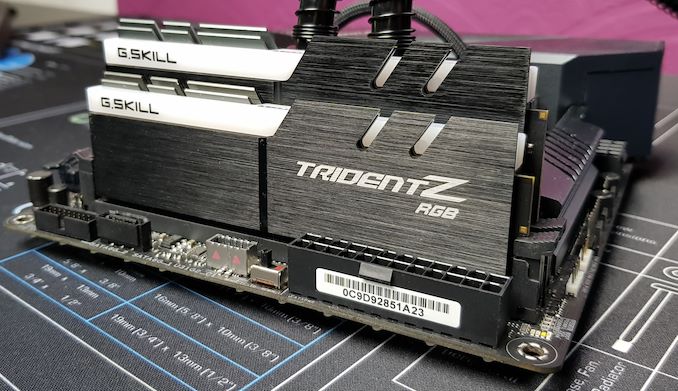
Comparing the smaller standard DDR4 to the newer DDR4 DC
The G.Skill TridentZ DC RGB memory doesn't differ stylistically from the 'standard' G.Skill TridentZ RGB memory. The main and only difference is in its height with the DC RAM measuring at a height of 60 mm, whereas the regular G.Skill TridentZ RGB sticks have a maximum height of 45 mm. This means the G.Skill DC modules are 33% bigger in size than the regular model. The heatsinks are made from aluminium and have a brushed finish, with one side grey and the other side black.
Along the top of the G.Skill TridentZ RGB DC memory is a plastic strip which diffuses the integrated addressable RGB LEDs. The RGB can be controlled by the ASUS AURA software or via G.Skill's own software.
ASUS and G.Skill both recommend users use liquid cooling methods on the CPU when this new memory is used due to potential issues when installing tower style air coolers that won't likely fit. This is due to the height clearance and the obstruction between the memory and either the side fans on a tower or the tower itself. For users angling the airflow top-to-bottom, the new memory can get in the way of heatpipes that like to stick out.
Although there is no information in regards to availability as of yet, the G.Skill TridentZ RGB DC memory is available in three different frequencies configurations. The first two are DDR4-3000 and DDR4-3200 kits with CL14-14-14-34 latency timings. The other kit is DDR4-3200 with slightly looser timings. All these kits have an operation voltage of 1.35 V and fully supports XMP 2.0 SPD. The kits are available in 64 GB kits (2x32 GB) only, are currently compatibility limited to three ASUS Z390 motherboards, and they operate in dual-channel.
| G.Skill's Trident Z RGB DC Kits for ASUS Z390 Platform | ||||||
| Speed | CL Timing | Voltage | Kit Config. |
PN | ||
| DDR4-3000 | CL14-14-14 34 | 1.35 V | 2×32 GB | F4-3000C14D-64GTZDC | ||
| DDR4-3200 | CL14-14-14 34 | F4-3200C14D-64GTZDC | ||||
| CL14-15-15 35 | F4-3200C14D-64GTZDCB | |||||
No pricing information has been provided by G.Skill or ASUS, but we expect pricing to be at the high end of three figures.
Comparing 2x32GB DDR4-2400 to 2x16GB DDR4-2400
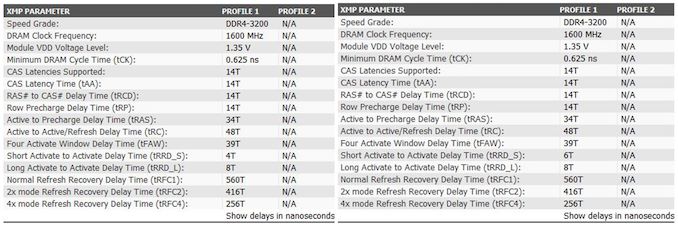
G.Skill TridentZ RGB DC (Left) and TridentZ RGB (Right) XMP 2.0 Latency Timings
When comparing the G.Skill DDR4-3200 14-14-14-34 TridentZ RGB DC UDIMMs (2x32 GB) to its DDR4-3200 14-14-14-34 TridentZ RGB UDIMMs (2x16GB), not much is different in terms of latencies. The only difference is that the DC TridentZ has a slightly higher tRRD_S which represents the number of clock cycles between activated commands from a different bank group.


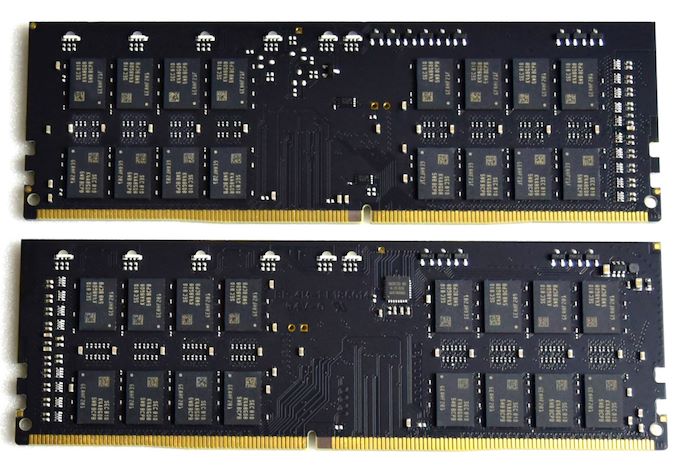

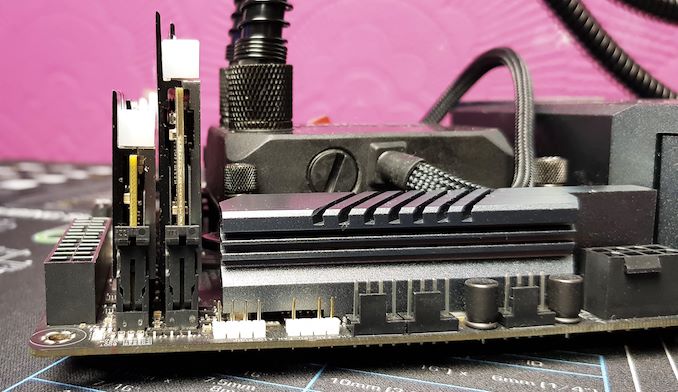
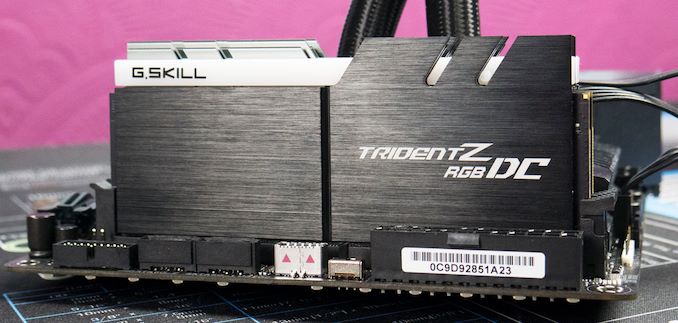








50 Comments
View All Comments
CheapSushi - Wednesday, January 23, 2019 - link
I honestly really love it aesthetically. It makes the rest of the motherboard balance out Z-height wise with PCIe cards. I know nobody else cares but there's something about it that I like. It's also an interesting solution; reminds me of early OCZ PCIe SSDs with dozens of chips on them. I would honestly love if these worked on quad and deca DIMM slot boards.SmCaudata - Wednesday, January 23, 2019 - link
I was pressed for time upon initial scanning and jumped to conclusion. Then I dug a bit deeper. In the conclusion you state that the G.Skill is substantially larger while the other only has a marginal height difference. This makes the ZADAK sound smaller, when in fact, the G. Skill double is actually the same size as the ZADAK single.G.Skill 45 mm height up to 60 for the double
ZADAK 60 mm height up to 73 for the double
Anyway. Based on percentage of size increases, yes, the G.Skill grew more, but you may want to consider some clarity in your description as there are a lot of people that just read the conclusion and may be concerned about size.
DanNeely - Wednesday, January 23, 2019 - link
I was confused too, because the ZADAK dimms looked significantly larger than the G.Skill.DigitalFreak - Wednesday, January 23, 2019 - link
This proprietary solution is pretty much DOA now that true 32GB DIMMs are supported by Intel on Z390 systems. All it needs is a BIOS update.nevcairiel - Wednesday, January 23, 2019 - link
Clearly the base technology would also scale up to using 16Gb dies for 64GB in one DIMM. The argument for small systems with only two slots still exists.The_Assimilator - Wednesday, January 23, 2019 - link
The number of people who want/need 64GB on a 2-DIMM-slot motherboard can be counted in the thousands, maybe. The number of people who want/need 128GB on a 2-slot motherboard can be counted on your fingers. This is a product without a market.yuhong - Wednesday, January 23, 2019 - link
The DDR4 spec only goes up to 16Gbit though.rocky12345 - Wednesday, January 23, 2019 - link
Great write up thank you.It also makes me see how much I need to upgrade my own system because I am still on DDR3@2200MHz with tight timings though but still I am sure this is holding me back a lot. My Aidia 64 latency score is like 42ns-43ns and I also thought that was fairly good and would help me get better responsiveness in my games and maybe it does. Like I said though my 2200MHz is probably really on the slow side when you think of DDR4@3200MHz and higher being able to push the systems so much harder.
Targon - Wednesday, January 23, 2019 - link
Why not test these on an AMD Ryzen based motherboard or two and see if they will work? Just because things are only officially supported on one platform or another doesn't always mean that they won't work. Also, Intel vs. AMD is very different in terms of memory support, and while it is more difficult to get DDR4 3633 and above working on the AM4 platform, if it works, it works. 3200 isn't a difficult speed at this point.Targon - Wednesday, January 23, 2019 - link
I disagree with the final paragraph where the focus is for SFF and motherboards with only two memory slots. If you have four memory slots and you can install 32GB in each slot, 128GB of RAM might be important for some people. What if you have a motherboard with more slots, if you really want/need the RAM and this stuff works, it doubles the allowed amount of RAM on the motherboard.The official specs for what a MOTHERBOARD supports are often limitations of the technology of the time. How many old machines said "Max 4GB RAM", because there were two slots, and at the time, you never saw 4GB memory modules. I've gone back to some of those old machines, and used 4GB modules to give 8GB of RAM in a machine that theoretically could only take 4GB.